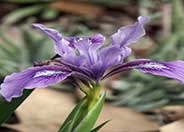
Common name:Douglas Iris
Botanical name:Iris douglasiana
Douglas iris is an evergreen perennial for shade or partial sun with blue violet spring flowers. It is a California native that is drought tolerant.
Maintenance Tips
Iris douglasiana is a small perennial wildflower that is native to California and Oregon. It matures at 1-2' tall and forms a clump of sword-like leaves that spread 3-4' wide. The flowers emerge above the foliage a few inches and are commonly a shade of purple. This is a very low-maintenance plant if it is planted in ideal conditions. These have evolved near creeks and naturally wet areas, so they are a great plant to use in swales or other lower elevations in the garden where water collects. In coastal gardens, this Iris is more drought tolerant, collecting their moisture from the overcast mornings. There is rarely any maintenance associated with these plants other than dividing them every few years if the clump becomes too large or dense.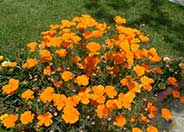
Common name:California Poppy, Golden Poppy
Botanical name:Eschscholzia californica
This small annual (sometimes acts as a perennial) plant will grow to less than 1' tall and has light, small blue green leaves with gold and orange flowers that bloom in spring and summer.
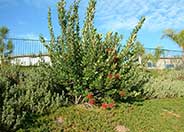
Common name:Toyon
Botanical name:Heteromeles arbutifolia
Toyon is a California native evergreen shrub that grows 6'-15' high and spreading 2'-3'. It has leathery toothed leaves, white summer flowers and clusters of red winter berries. It tolerates full sun or partial shade, heat, smog, wind and heavy or light soils. It is drought tolerant, attracts beneficial insects and hummingbirds.
Maintenance Tips
Heteromeles arbutifolia is an evergreen shrub that typically grows 6-8' tall and wide. It is a very versatile plant that can also be shaped into a small tree reaching 12-15' tall if it is cultivated properly. It has a very dense branching structure and will form into a large mound of green foliage and bright red berries if left unattended. The location, space, and desired shape of this plant in your garden will determine how it should be maintained. In a naturalized garden, where it is given plenty of space to reach maturity, there so almost no maintenance involved. However, if it is located in areas with a moist climate, some thinning would be necessary for good airflow to avoid fungal diseases. If is being used as a small tree, the cross branching and lower branches should be removed as they form to encourage the desired shape of the tree. It prefers full sun, is very drought tolerant, and is unparticular about its soil conditions, so it can be grown just about anywhere.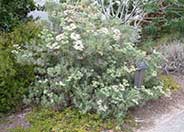
Common name:Santa Cruz Island Buckwheat
Botanical name:Eriogonum arborescens
Santa Cruz Island Buckwheat is a loosely branched shrub growing 2'-5' high and wide with shredding, gray to reddish colored bark, grayish foliage, and creamy pink spring flowers. It is a CA native, drought tolerant, attracts butterflies and beneficial insects.
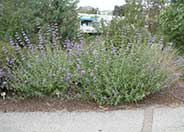
Common name:Purple Sage
Botanical name:Salvia leucophylla
The Purple Sage is an evergreen shrub that grows 2'-3' tall and 5'-6' wide. It has white stems and leaves and light purple flowers that bloom between May and June. This shrub tolerates heat and drought. The Purple Sage is a California native.
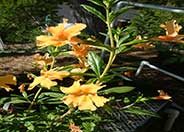
Common name:Sticky Monkey Flower
Botanical name:Mimulus aurantiacus
Sticky Monkey Flower is a drought tolerant evergreen shrub 2' tall with numerous, orangish yellow flowers in spring and summer. It is a California native that attracts hummingbirds. This shrub can be found on the dry hills and canyon slopes in the Sierra Nevada foothills and the central Coast Ranges.
Maintenance Tips
Mimulus aurantiacus is a California native herbaceous perennial. It has masses of orange, tube-like blossoms that are attractive to pollinators, such as bees and hummingbirds. It has thin, glossy leaves and can grow up to 2' tall and wide. Flowers will appear on flower stalks for most of the year but will show up in high numbers in the spring and until summer. Throughout the flowering season, just remove flower stalks from the base, as needed, when each stalk has appeared to stop sending out new flowers. In the late summer, you can cut back the foliage by one-third of the current size and remove any additional branches that have died back.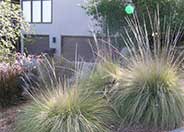
Common name:Deer Grass
Botanical name:Muhlenbergia rigens
The Deer Grass is a warm season perennial that forms dense clumps from the base. The spike-like flower stalks grow 3' tall and this grass has striking foundation form. The Deer Grass is native to California and needs watering once or twice a month after it has been established. The more water it has, the greener it is.
Maintenance Tips
Muhlenbergia rigens is a dense grass with a dome-shaped structure arching in all directions. It is commonly referred to as Deergrass. The foliage can reach 3' tall and 5' wide with flower blooms that emerge in the spring and summer 18" above the foliage. This grass requires almost no maintenance if it is planted in its ideal conditions. A sunny location, well-drained soil, and the space to reach its mature size will ensure that it thrives without having to prune for size or shape. It is common to cut back perennial grasses very hard in the winter to prune off the old spent flowers. If you are planning on winter pruning, it is best to wait until you see some new foliage emerge so the newly emerging leaves can cover the cuts quickly.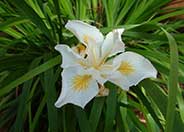
Common name:Iris 'Canyon Snow'
Botanical name:Iris Pacific Coast Hybrid 'Canyon Snow'
Iris 'Canyon Snow' is a beautifu, white flower with a yellow throat. It is one of the best performing of the Irises. It tolerates regular garden conditions and does not struggle through the summer. It is not a fussy plant, as there is little to no maintenance, once established. Like most Irises, the bloom period is fairly short. It looks best in mass plantings. It prefers partial to full shade.
Designer: Seaside Gardens
Photographer: GardenSoft
Incorporate compost 6" into your soil to retain water, reduce compaction, feed earthworms, and provide valuable nutrients to your plants.
Drip and other smart irrigation delivers water directly to roots, allowing no excess water for weeds.